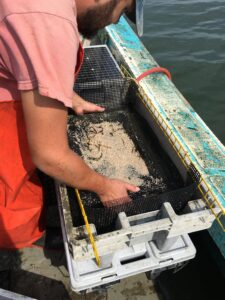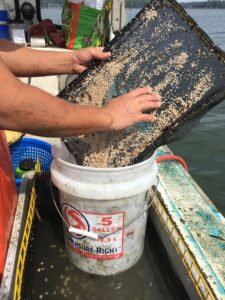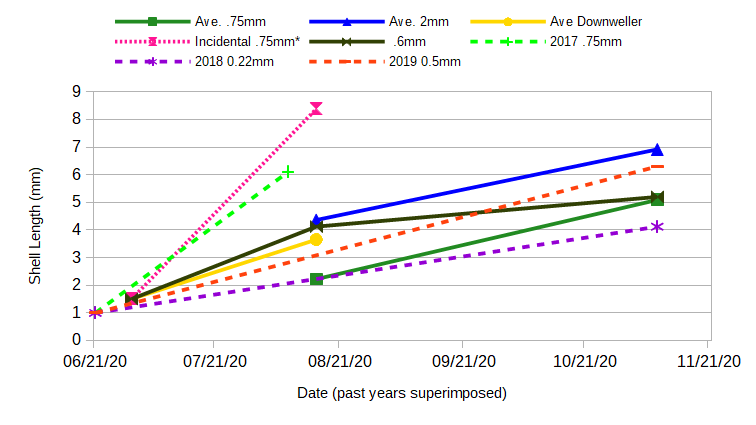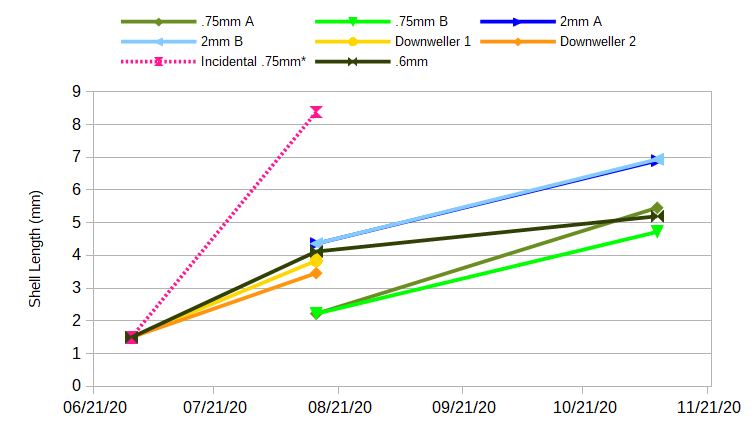Final report for FNE20-955
Project Information
This project tested three seed-clam sizes for growth, retention, and mortality over the 2020 farming season as part of a subtidal polyculture with oysters. Its intent was to address the need for larger seed established in prior research of this intensive farming technique (which provides farmers with additional crops, resilience to disease and changes in the market, and reduces spatial pressures on both wildlife and human users). Because large seed had been unavailable in this part of the northeast, a small-scale downweller was constructed to produce the large seed for this project. A "minimum viable" seed size (based on amount of growth) and an "optimum" seed size (that takes into account prices of newly available large seed in other regions) were calculated. Seed that retains on .75mm mesh performed best by both criteria. Results were shared through social media, webinars and outreach to farmers in an aquaculture co-op. As a part of this outreach, two thirds of seed reared in this experiment were distributed for other farmers hoping to try the technique.
This project aimed to find a “minimum-viable” and “optimal” seed-clam size that can be grown in a polyculture with oysters on subtidal farms in the method described in SARE projects FNE17-877 and FNE18-901, using inexpensive conventional aquaculture equipment (mesh shellfish bags). Success of treatments were gauged by growth (change in shell length), value (amount of growth per seed cost) and mortality. This information will help inform farmers when choosing clam seed, and will hopefully pressure more hatcheries to offer the slightly larger seed sizes that work best in this polyculture system. Availability of larger seed would remove barriers to entry for farmers by eliminating the most difficult portion of the nursery-phase of clam production, allowing them to diversify their crops and expand their farms without increasing their overall footprint.
The goal of the downweller-assisted portion of this experiment was to produce the large seed that enables the main tests described above. It was included because larger seed was not available in this part of the northeast at the start of this trial.
Most subtidal seafarms are monocultures, making them vulnerable to diseases, pests, and market fluctuations. Though shellfish aquaculture is generally considered one of the most environmentally friendly forms of food production, its rapid growth in the region has the potential to cause conflict with other users (both commercial and recreational), and could put more pressure on wildlife as farms expand their footprints to increase production of a single crop.
The addition of complimentary crops that utilize different food resources and portions of the water-column would let farms expand by becoming more intensive instead of larger. Intensive polyculture would allow farms to increase their yields while lessening the impact on wildlife and human users.
A polyculture of eastern oysters and littleneck clams (studied by the applicant in SARE farmer grants FNE17-877 and FNE18-901, and collaboratively in SARE partnership grant “Expanding quahog and oyster polyculture in Maine” and National Seagrant project “Investigating the viability of quahog and oyster aquaculture in Maine”) allows farmers to diversify their crops within current farm footprints by growing oysters in surface waters and clams in the sediments below. This work has shown promise, with the first crop of clams beginning to reach market size in two years with low operational costs and a favorable wholesale price. The technique has garnered strong interest, with a backlog of farmers hoping to participate. The biggest hurdle holding back wider adoption and further experimentation is the lack of large seed-clams and difficulty rearing the very small seed that is available in this part of the region (until spring of 2020, only 1mm seed was available in Maine).
Nursery work for these projects has proven challenging. The initial tests in 2017 saw by far the fastest growth, with 1mm seed clams reaching an average length of 11mm by the end their first season (5 months after planting) and 22mm by the end of their second (17 months). The 2017 tests had the lowest seed retention (40%) largely due to mechanical losses (clams sifting out of their initial .75mm mesh). In 2018 and 2019 seed clams were grown in smaller meshes (.25mm and .5mm respectively). These meshes nearly eliminated sifting losses, but greatly slowed growth. Clams from the 2018 planting only reached 4mm in their first season and 15mm in their second. The 2019 planting averaged 6mm at the end of their first growing season. This data suggests that the smaller meshes needed to adequately contain 1mm seed-clams prevent the free flow of plankton and other food, and that larger seed is necessary to allow for larger initial meshes and free, unassisted feeding.
Since larger seed was not available in this part of the northeast (due to agricultural-quarantines and regulation of interstate seed sales), a micro-scale downweller (nursery equipment) was built to produce larger seed at a small, experimental scale. The large seed produced in the micro-downweller was graded and used in growout trials to determine a viable seed-clam size for unassisted feeding in the subtidal clam/oyster polyculture system.
I am the owner of Winnegance Oyster Farm, located on the New Meadows River in southern Maine. The farm is in its seventh year of operation. I began harvesting in September of 2015 and switched from part-time to full-time work at that point.
My farm is comprised of four limited-purpose aquaculture licenses (LPAs) encompassing 1600 sqft. In 2020, the farm had the capacity to produce over 75,000 oysters, with 90,000 planned for harvest in 2021. Additionally I grow quahogs, urchins, scallops, and sugar-kelp.
I sell the bulk of my oysters through shellfish dealers. Oyster sales were sharply down in 2020 despite increased farm capacity- (approximately 30,000 pieces compared to 71,000 pieces in 2019). These losses are directly related to COVID 19 market disruptions. Several thousand clams reached a marketable size this season, though most have been retained for harvest-stage handling experiments. Existing farm infrastructure was used for this experiment (including oyster cages and longline space).
Cooperators
Research
300,000 1.5mm seed-clams were procured for the project at earliest availability (June 30, 2020) and were reared on-site in a micro-scale “downweller” for 6 weeks. A downweller is a device that pumps unfiltered seawater water into screens that hold shellfish seed- accelerating growth by providing a constant supply of food. Downwellers (and the more common upwellers) are typically large and prohibitively expensive pieces of nursery equipment. The micro-downweller used here was designed to facilitate an experiment of this size and is not a farm-scale piece of infrastructure. It was constructed from a six-bag oyster cage, a salt-water bilge pump, a timing switch, a marine battery, weatherproof dry-boxes, and a 12V solar panel. It pumped water into 6 nursery bays constructed from .6mm mesh paint-straining trays capped with bucket lids. The downweller-assisted feeding portion of the project was included to produce the larger seed needed for the growth experiment. A control treatment skipped the downweller phase and was deployed in the same .6mm mesh paint-straining trays, lidded with 4mm mesh. An inadvertent pseudo-treatment was created when a large storm washed a portion of clams from a control tray into .75 mm mesh (these results are included with a caveat- stocking density was much lighter).
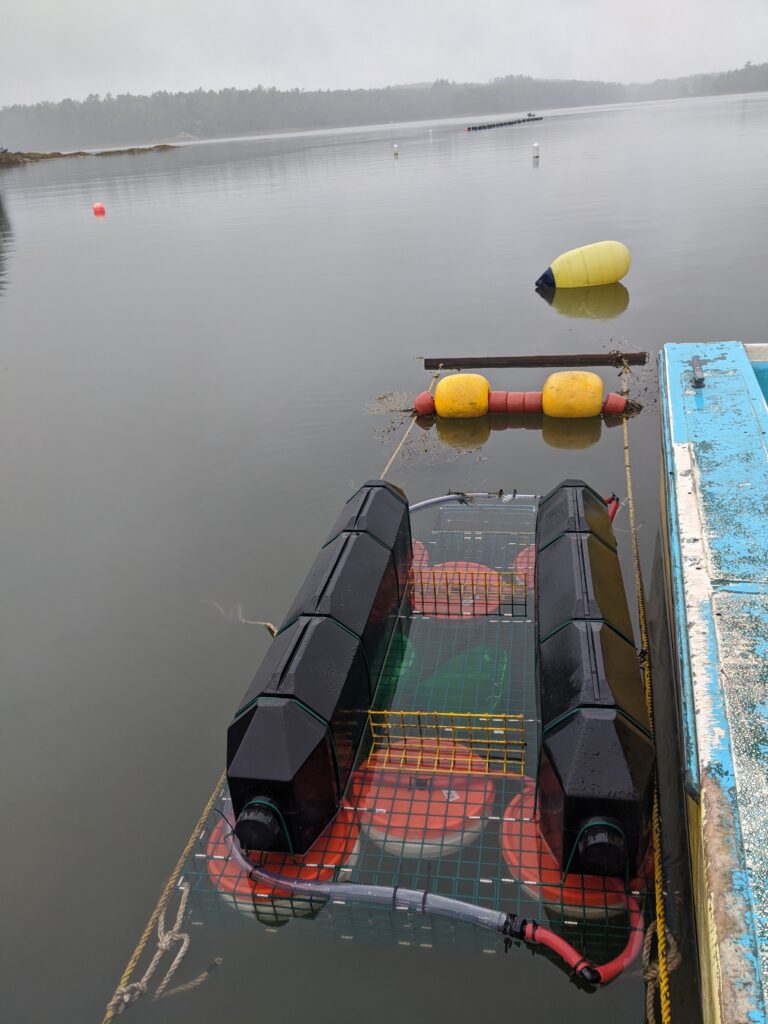
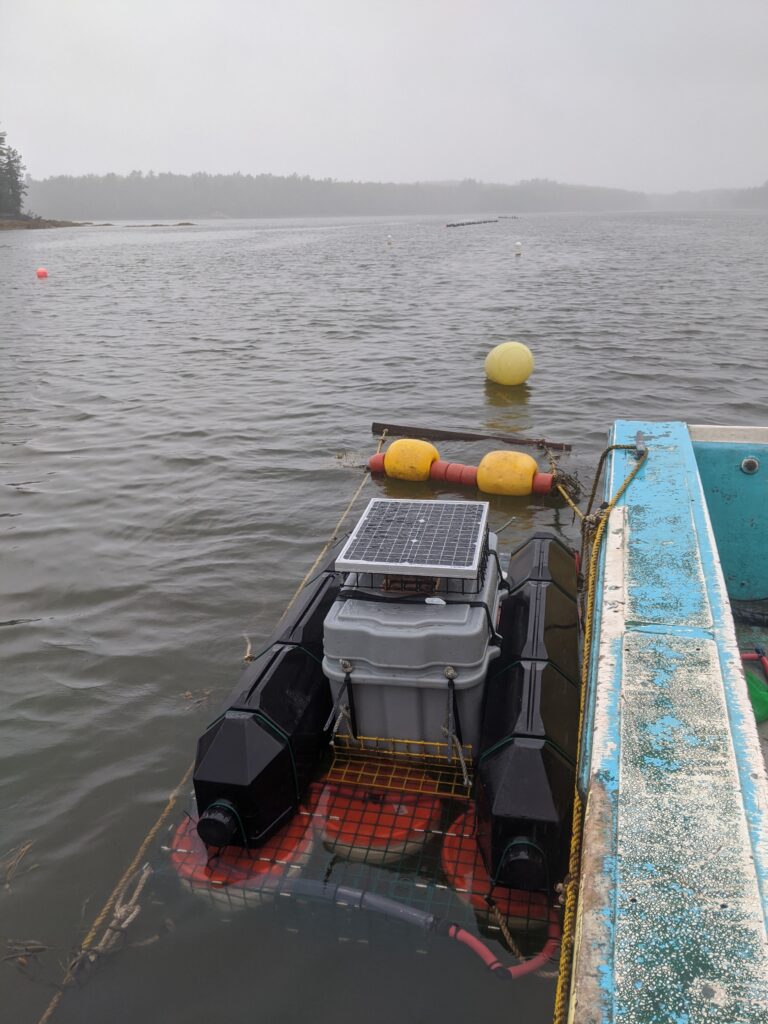
After six weeks in the downweller, clam seed was graded using sieves for the main experiment. Graded seed was deployed in .75mm spat bags and 2mm diamond mesh bags. Seed was not large enough to be retained in 4mm square mesh oyster bags (an additional proposed treatment). Treatments were defined by these initial mesh sizes and were not mixed or re-graded over the course of the experiment.
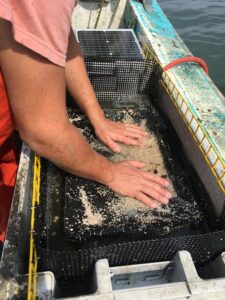
All treatments were checked for bio-fouling every other week during the growing season. All clams were grown in floating oyster nursery cages. Measurements of growth (change in shell length), mechanical loss, and mortality were measured in November of 2020 to determine the minimum- initial seed size needed for the polyculture technique to be viable.
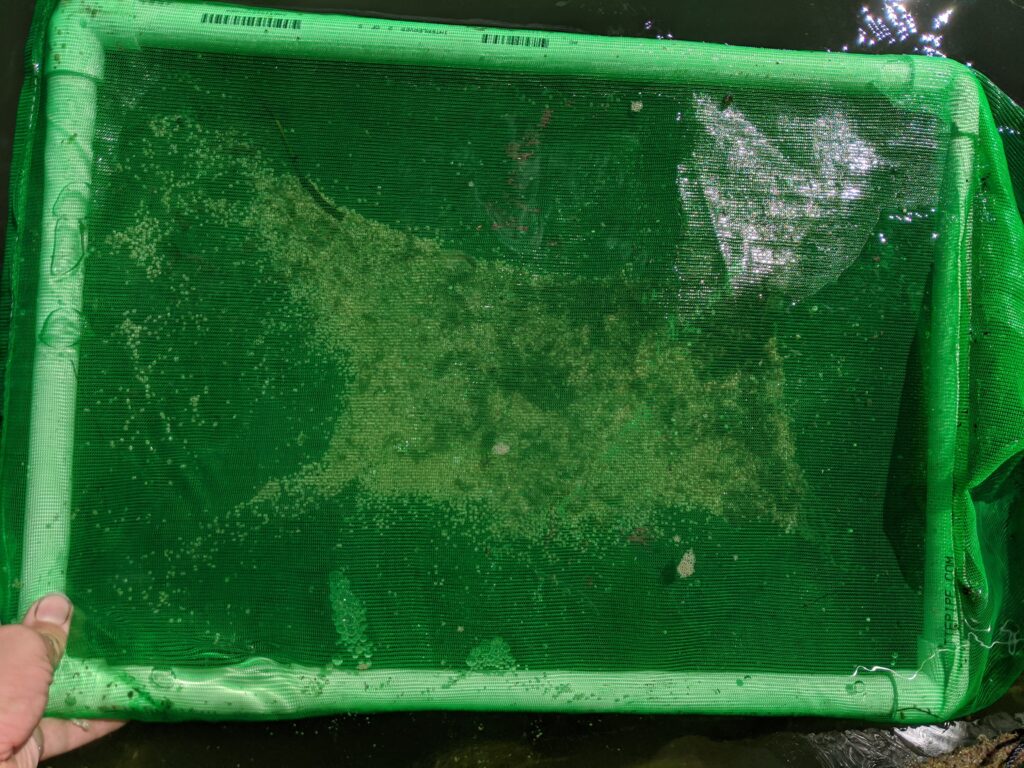
Downweller and initial nursery performance
Seed emerged from the downweller with an average shell length of 3.7mm (2.2mm of growth).
Seed grown unassisted in .6mm mesh trays were slightly larger, averaging 4.1mm (2.6mm of growth). Seed that washed into a .75mm spat bag grew much larger- averaging 7.4mm shell length (6.9mm of growth) though this inadvertent treatment had a much lower stocking density. In 2017 smaller seed was grown in .75mm mesh during a similar period of the growing season growing 5.1mm to a length of 6.1mm).
Downweller performance was very disappointing: A prolonged period of rain and fog in the beginning of July prevented the downweller battery from adequately recharging, reducing pump time and active feeding. When consistant sunny weather returned after the first 10 days in the downweller, pump/feeding times were adjusted- pumping 10 minutes out of every hour. This was all the system could provide and proved inadequate. Apart from inadequate pump/feeding time, my design for the growth-chamber closures unnecessarily reduced natural flow to the clams. The intent was to securely contain clams and hold feeder hoses in place. A mesh lid that allowed passive flow/feeding when the pump wasn’t running would be used in future designs.
Clams in passive nursery trays and bags performed better than the clams in the downweller, particularly the small number of clams in .75mm mesh. Though their higher growth may be due to a much lower stocking density, they had results most similar to clams grown in .75mm mesh during a similar time period in 2017. The 2017 clams were adequately stocked and also showed much stronger growth than smaller meshes (with or without downweller assisted feeding) in all years of related research (see chart 1).
| Downweller & Initial Nursery | Growth in mm | % Change |
| Ave Downweller | 2.2 | 143% |
| Downweller 1 | 2.3 | 156% |
| Downweller 2 | 2.0 | 131% |
| .6mm Mesh | 2.6 | 175% |
| .75mm spat bag* | 6.9 | 459% |
| 2017 .75mm spat bag** | 5.1 | 510% |
| *Low density bag **Smaller initial size, 18 additional growth days | ||
Chart 1: Nursery growth (multi-year)
Chart 2: 2020 Nursery growth
After the initial period in the downweller, seed was sieved and graded. From the graded seed, two treatments were deployed, one on .75mm mesh (average initial seed size 2.22mm) and another on 2mm mesh (average initial seed size 4.36mm). In November, seed grown in .75mm mesh had grown 2.9mm on average to a length of 5.09mm. Seed in 2mm mesh grew an average of 2.6mm, to an average shell length of 6.92. Ungraded seed (grown from the start in .6mm mesh) grew 1.1mm during this time period to a length of 5.2mm.
| Nursery Growth Experiment | Growth in mm | % Change |
| Ave. .75mm Green Spat | 2.9 | 129% |
| .75 Green Spat A | 3.2 | 146% |
| .75 Green Spat B | 2.5 | 113% |
| Ave. 2mm Diamond | 2.6 | 59% |
| 2mm Diamond A | 2.5 | 58% |
| 2mm Diamond B | 2.6 | 59% |
| .6mm Mesh | 1.1 | 26% |
Seed in .75mm mesh gained more shell length (and % change in shell length) compared to clams grown in 2mm diamond mesh, despite the fact that 2mm mesh allows for more flow (and theoretically, more feeding). A number of factors could account for this. Clams were much more likely to stick to the 2mm diamond mesh (or poke partway through it). This could mechanically inhibit feeding, preventing clams from fully opening to siphon seawater. The 2mm diamond mesh also appeared to foul with invertebrates more quickly and with different (and more harmful) species than the .75mm mesh. 2020 was an exceptionally bad year for fouling- with overlapping waves of invertebrate sets over the course of the season. These unwanted invertebrates could have slowed growth by competing for food with clams.
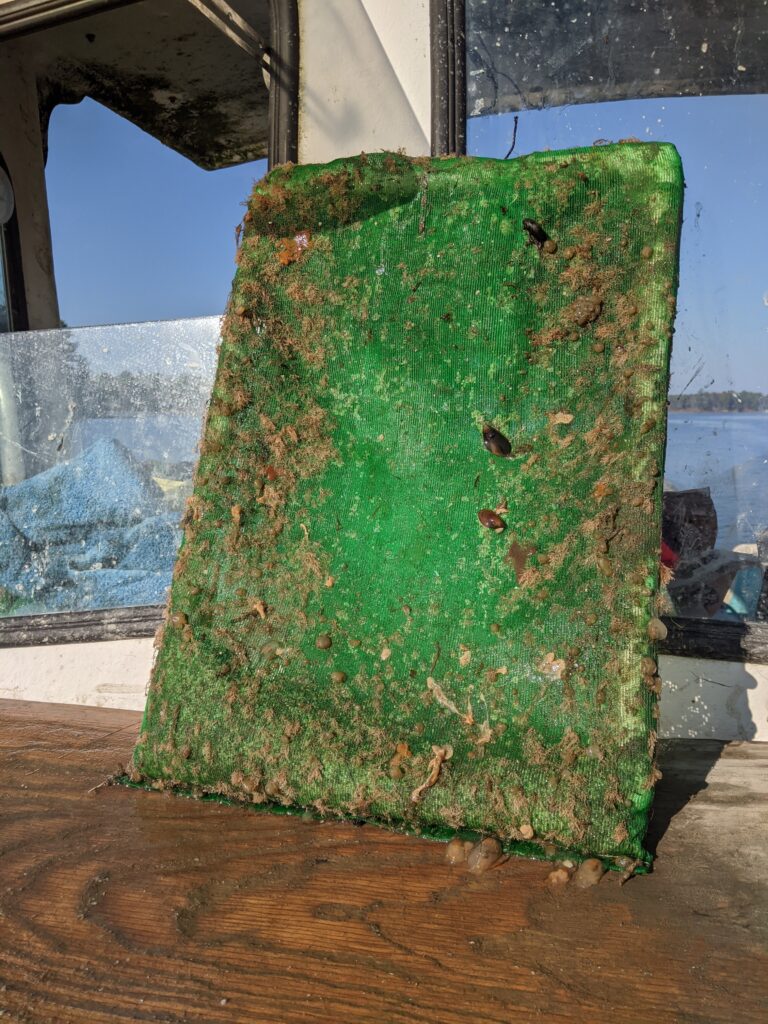
Cost of Growth:
| Late Season (mid Aug to mid Nov) | ||||
| Mesh Size |
Ave. seed clam price $/1000 seed |
Growth amount | Cost/mm growth | Size @ end of season |
| 0.6mm | $7.00 | 1.1 | $6.48 | 5.2 |
| 0.75mm | $10.47 | 2.9 | $3.65 | 5.1 |
| 2mm | $16.67 | 2.6 | $6.51 | 6.9 |
| 4mm (2017) | $38.00 | 5.0 | $7.62 | 11.1 |
In the full scale nursery experiment conducted from in the latter half of the season (mid August until mid November) seed contained in .75mm mesh grew more than seed large enough to deploy on 2mm mesh. This smaller seed was also less expensive. When looking at the amount of growth observed per dollar spent on 1000 seed, clams retained on .75mm mesh showed a clear advantage- costing $3.65/mm of growth versus $6.48 for .6mm mesh, $6.51 for 2mm mesh and $7.62 for 4mm mesh* (data from 2017- clams did not reach a large enough size to test 4mm mesh in 2020).
| Early Season (late June to early Aug) without downweller | ||||
| Mesh Size | Ave. seed clam price | Growth amount | Cost/mm growth | Size @ start of Aug |
| 0.6mm | $7.00 | 2.6 | $1.67 | 4.1 |
| 0.75mm (2020)* | $10.47 | 6.9 | $0.52 | 8.4 |
| 0.75mm (2017)** | $10.47 | 5.1 | $1.06 | 6.1 |
| *Low density bag **Smaller initial size, 18 additional growth days | ||||
I did not plan to compare early season growth in multiple passive feeding treatments (without using the downweller) in this experiment. This was due to the lack of availability of large seed during project planning.
The surprise availability of 1.5mm seed for this project and the incidental .75mm treatment allowed for an imperfect comparison of .6mm mesh and .75mm mesh in this early part of the season. Though the difference in stocking density could explain some of the difference in growth between these treatments, similar growth rates from 2017 (the one other year seed was grown from the start in .75mm mesh) suggest that mesh size may be the driving force during this stage.
The much higher growth rates of clams starting the season in .75mm mesh compared to clams that were transplanted in .75 mesh in August suggest seasonality is also an important factor. Clams deployed in .75 mm mesh at the outset of the season grew at a faster rate than any of the other treatments.
This suggests that seed clams that retain on .75mm mesh early in the season would offer a better value than larger and more expensive clams that arrive later.
| Shell length (mm) | Min. mesh size (mm) | Ave. price | Month available from hatchery |
| 1 | 0.6 | $7.00 | June |
| 1.5 | 0.75 | $10.47 | June-July |
| 2 | 1 | $16.67 | July-Aug |
| 4 | 2 | $22.62 | Aug-Sept |
| Price averages and availability dates calculated using price-lists from the three closest hatcheries (in ME and MA) | |||
Mortality and Mechanical Loss:
Mortality and mechanical loss were intended to factor into the cost/benefit analysis of seed size and growth. For different reasons, these measures have been left out of my analysis
Mortality: A high percentage of clams in the study died at a shell length of 2-3mm. A similar mortality event was recorded for 2-3mm clams in another experiment on my farm and on collaborators’ farms in three other locations (with clams in varying mesh sizes). Mortality recorded in .75mm mesh may be skewed high if sick, weak, or newly dead clams were present during sieving and grading (all clams from this size class would end up in .75 mesh). In all other years of related research, there was no substantial mortality at this size (or in the nursery-phase in general).
| Mesh Size | Mortality (%) |
| 0.6mm | 2 |
| 0.75mm | 17 |
| 2mm | 2 |
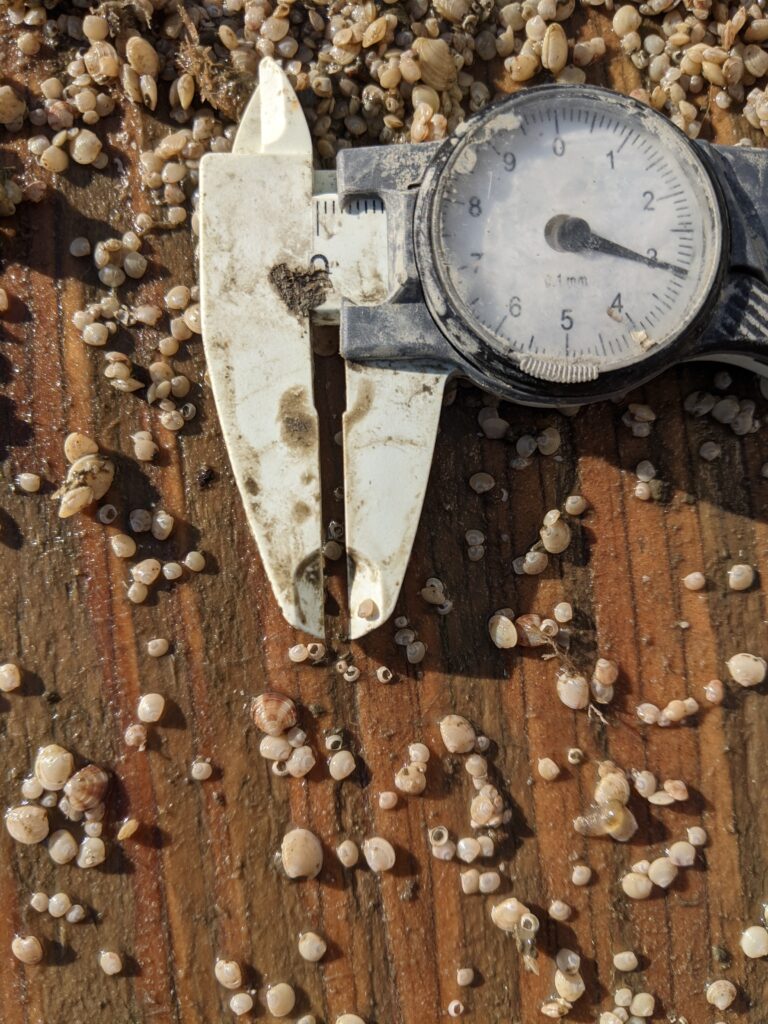
Mechanical Loss: Stocking densities were calculated by different observers at the beginning and end of the experiment. Volunteer observations establishing the initial stocking densities of the treatments greatly over-counted seed. When working with tiny (sesame-seed sized) live animals, stocking densities are calculated by establishing a known number of individuals in a manageable volume and multiplying find the full volume. Handling 2mm clams can very be difficult. In future studies, handling, measuring, and counting of small seed will be performed by the project PI.
Field observations do offer some information on seed retention for this project. The .75mm mesh easily retained all graded seed (ave. shell length 2.22mm) without any loss through the mesh. Seed loss was observed in the larger 2mm diamond mesh even after grading (ave. shell length 4.36mm). Clams that had initially retained on 2mm screen shifted and sifted through mesh over time with wave action. The amount of loss appeared small, but this is speculative without an accurate account of initial stocking density.
This project sought to find a “minimum viable” and “optimal” clam seed size for passive nursery growth. The results from this project strongly suggest that seed that retains on .75mm mesh (roughly 1.5-2mm) is the answer for both of these questions. This seed had the best growth rate in this trial, is available early in the season when growth rates were highest, and had the best ratio of growth to cost.
The 1mm seed that was the sole option in prior years had been a major bottleneck to full scale adoption of this farming technique. 1mm clams would either grow at fast rates in .75mm mesh with high mechanical losses (as in the 2017 study) or would stagnate in smaller meshes that retained seed well but greatly reduced feeding. The newly available 1.5mm and 2mm seed will allow me (and other farmers) to bypass this stagnation and mechanical loss, and still put plant clams in a nursery early enough in the season to see substantial growth (459% growth in early season growth, 129% in late season growth).
Questions about mortality in 2-3mm seed will still need to be addressed to unequivocally endorse this nursery plan- though losses in other projects and lack of nursery mortality in three other years suggest this could be a distinct mortality event -unrelated to mesh size.
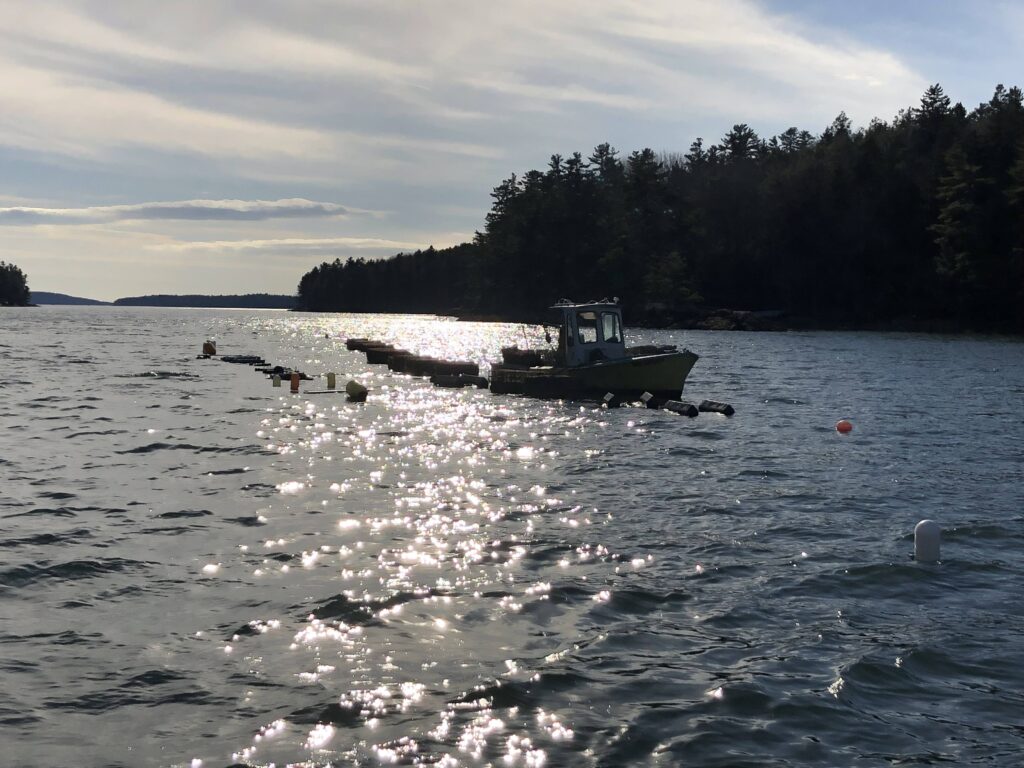
Education & Outreach Activities and Participation Summary
Participation Summary:
Emails, phone calls and social media messages were used to communicate with farmers interested in this work, with the vast majority of contacts focusing on the downweller- for use with either clams or oysters (includes 5 in-depth consultations).
Clams from this project were distributed at no cost to 5 sea-farmers in the watershed- to allow them to continue this work on their own farms (listed under workshops/field days)
An account of this work was presented to an introduction to aquaculture course attended by 30 participants (~25 aspiring farmers, 5 agricultural service providers) and was additionally shared with 10 members of an aquaculture co-op.
Project progress was shared via social media garnering 1478 engagements. Social media and press for prior clam research on the farm in Aquaculture North America drove 3786 visits to the farm's website and research page.
Learning Outcomes
- Awareness of clam-oyster polyculture as a crop diversification strategy
- Awareness of gear choices/rigging
- Willingness to try polyculture on farms
- Knowledge of seed-size choice and potential outcomes
Project Outcomes
This project will change the way I operate my clam nursery. I will order larger seed (1.5-2mm) that I will plant early in the season. This will allow for much quicker clam nursery turnover, which will require less space to be taken away from my oyster growout operation.
Additional farms growing quahogs will help build product awareness and market in a region where soft-shell clams are a much more common crop.
I think this project's main success is that it pretty clearly showed that there was a big performance advantage to .75mm mesh compared to the smaller meshes used in prior experiments, and that seasonality plays a large role in growth. If I had known that larger seed would become available, I would have more directly tested unassisted early season growth- with multiple replicates of 1.5-2mm seed grown in .75mm mesh. Unfortunately I had already bought seed when this was announced.
The stocking density observations were clearly a mistake. There is subjectivity to any measurement that requires a visual estimate and I would make sure that I was the observer at all stages in any future project.
I will continue to advocate for clam-oyster polyculture. The process works, the product it produces is very high quality, and it offers opportunity to other small-scale farmers (who are increasingly under pressure from industrial scale aquaculture). The more farmers that try this technique, the faster we will work out the kinks in the process. There is particular need to troubleshoot the near-harvest stage handling of polyculture-produced clams.
This project also showed the strong interest and demand for an inexpensive small-scale upweller or downweller for all types of shellfish farms. This interest could warrant testing the prototype used in this project with a larger solar panel, higher capacity batteries, and/or a different growth chamber design.
